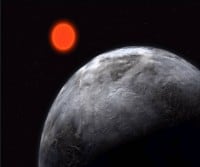
WE ARE NOT ALONE

Evidence of complex life confirmed on Gliese 581c
- Dateline
- 12 June 2030
The images that arrived back at the Harvard-Smithsonian Center of Astrophysics last night are nothing short of astounding. They clearly show large ‘animals’ the size of dinosaurs standing in what appears to be swampy marshland on a steamy planet.
The new LAMP (Light Amplification by Matrix Propagation) technology has beamed back images from multiple sources across more than 20 light-years, in surprising clarity and detail.
The 50-year-long search for extraterrestrial life is over; this is the first observance of complex life forms similar to our own.
Evolutionists will say that this is the absolute proof that life is not simply the result of a single ‘creation event’ but that it evolves in parallel in many similar environments. Creationists have been crying foul and are asking scientists to “show us the proof.”
A YouTube clip posted this morning claims that the whole thing was created in a graphics studio in Burbank. The Harvard-Smithsonian has dismissed the video as an ‘obvious hoax’.
Astrophysicists have now identified more than 500 other Earth-like planets that could harbor life. The new galactic gold rush has begun.
ANALYSIS >> SYNTHESIS: How this scenario came to be
Is there anybody out there?
An eternal debate rages between scientists, philosophers and theologians: Is Earth unique? Are we the only planet, in the only solar system, that is fortuitously able – or designed – to support life?
This vexing question is easy to answer if you have faith that we are ‘special’ – and the only example of a higher order of existence in a boundless universe.
But if you accept the fact that there are billions of galaxies, with hundreds of billions of stars, with many more planets of all types, then surely logic tells us that the chances of one – or more – of those planets supporting life is immense. Why should we, a mere speck in the eye of the cosmic microsecond, be the only rocky, wet world where molecules combine, replicate, mutate and evolve to form complex, organic, sentient beings?
Astrophysicists believe that these organic molecules were present in the cloud of dusty gas from which our solar system formed, providing the raw materials for life on Earth. Astronomers can see these molecules throughout our galaxy, which is one reason why many believe conditions may also be ripe for life in other parts of the Milky Way, and perhaps even further afield.
As science and technology advance in increasingly exponential fashion, we are presented with more and more evidence that we are probably not unique. But proof of life eludes us. Even as we discover evidence of water on Mars and moisture signatures on distant exoplanets, we continue to search for that ultimate indicator of complex life, an intelligent signal – communication.
But in the absence of an identifiable message from ‘out there’, any image of creatures, even algae, on another planet would seal the issue. As our ability to ‘see’ into distant stellar regions improves, we may yet get the picture.
What will be the reaction when we do?
Links to related stories
- A New Earth? - Guardian G2, 6 November 2007
- Scientists discover second Earth - CNET News, 17 October 2007
- Could this be Earth's near twin? Introducing planet 55 Cancri f - Guardian, 7 November 2007
- Why on earth look for a planet like ours? - The Telegraph, 12 November 2007
- New evidence for extragalactic life-forming matter - New Scientist, 13 November 2007
- MindBullet: THEY CAME FROM MARS - WE ALL DID (Dateline: 21 March 2014, Published: 03 May 2007)
Warning: Hazardous thinking at work
Despite appearances to the contrary, Futureworld cannot and does not predict the future. Our Mindbullets scenarios are fictitious and designed purely to explore possible futures, challenge and stimulate strategic thinking. Use these at your own risk. Any reference to actual people, entities or events is entirely allegorical. Copyright Futureworld International Limited. Reproduction or distribution permitted only with recognition of Copyright and the inclusion of this disclaimer.